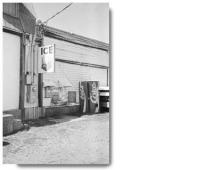The Ice Machine Leaveth

The iron heart that kept its familiar "ta PA ca, ta PA ca . . ." rhythm on the banks of Fort Pond Bay since April 1, 1939, stopped beating over the weekend. An era ended with it.
It was one of the last of its kind. The Atlas model 1929 Imperial mechanical-injection diesel engine had powered the ammonia compressor at the Perry B. Duryea and Son ice-making plant on Tuthill Road for nearly 60 years. It has been retired, and will not be replaced.
It was the old Imperial's exhaust system that produced the distinctive sound that was so much a part of Montauk life that longtime Montaukers no longer heard it. "I only noticed it when it was not running," Perry (Chip) Duryea 3d said on Monday.
Before The Atlas
His grandfather, Perry B. Duryea Sr., bought the Atlas in 1939 in order to supply ice to fishermen more consistently. His company had offered ice since the early 1920s, but it was nature's ice, not compressor made, and mined from nearby Tuthill Pond. The ice harvest usually took three days and a crew of 35 men and horse.
First the horse was fitted with "caulks" or cleats for traction. It was walked back and forth pulling a tool that cut a furrow in the ice for the sawblades to follow. After the sawing, blocks weighing 300 pounds each were lifted onto a roller conveyor and pulled into the ice houses for storage.
The Duryea ice houses were destroyed in the hurricane of 1938. For several winters prior to that storm, a warming trend had made the ice harvest undependable. It was therefore decided to supply the rebuilt facility with the Atlas-Imperial.
Recipe For Ice
It was a big, slow-turning engine that chugged along at only 360 revolutions per minute. The shaft was turned by three eight-inch-bore cylinders that produced 55 horsepower. The 800-pound flywheel rumbled on its large bearings.
Powered by a stainless steel shaft, the compressor turned ammonia gas to a cool liquid, which then stole heat from a calcium chloride brine piped through an ammonia chamber before being returned to the cold pool under the building. Metal molds filled with fresh water were lowered into the cold brine. Ice was made.
The Atlas-Imperial did all this - making 10 tons of ice a day while burning only 72 gallons of fuel.
Ice-making at Duryea's was geared to the fishing season. During the summer, the old Imperial ran 24 hours a day to supply ice for local shippers of fish, and for the Duryeas' lobster delivery trucks.
Collector's Item
On Tuesday, Chip Duryea said the Atlas-Imperial had simply outlived its usefulness. "The whole rationale of the 300-pound block ice was to bring them to the harbor to be crushed. Most boats have their own ice-making capability," he explained. And so, the grand old machine will not be replaced by newer equipment.
It will keep on chuggin' however. Mr. Duryea said it had been donated to a collector of antique machinery who has pledged to keep the Atlas-Imperial going.
As for the ice-house, it will be converted to a retail shop pending the approval of an overall plan now before the East Hampton Town Planning Department. The wholesale lobster business will continue into the foreseeable future, Mr. Duryea said, as would the Lobster Deck restaurant.
The overall plan before the town includes an expanded restaurant and deck, and several retail shops.
